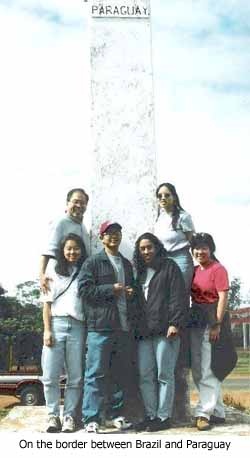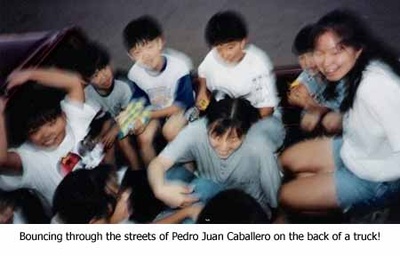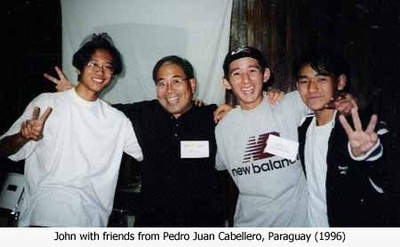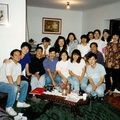Beisebol is big among the Japanese farming colonies of South America. I found myself at a weekend tournament in Pedro Juan Caballero, a small town in eastern Paraguay on the border of Brazil. As I wandered around, it occurred to me that it wasn't just about baseball. It was about community. It was certainly a chance to watch various games and rivalries played out, but it was also an opportunity to visit, to picnic, to laugh, to gossip.
Onigiri (rice balls), umeboshi (pickled plums) and chicken seemed to be the food of choice that day. There were kids walking around with Okinawa dango (dumplings), an assortment of senbei (rice crackers), those Japanese gummy candies and saki ika (you either love it or hate it).
There were watermelons chilling next to chunks of block ice in galvanized washtubs. (I hadn't seen that since I was 10 years old!) Throw in the older folks with their Asahi Super Dry and Sapporo and you've pretty much got the picture.
As I look at the older people I think of the Japanese who immigrated to Paraguay in the 1950s and '60s. Their history was related to me through various conversations I would have with community leaders. The first immigrants to Pedro Juan Caballero (Colonia Amambay) found land to be fertile for agricultural use. Small patches of land were cleared and small experimental coffee crops were planted. The coffee plants thrived and the expectation was that this would be a good site for a larger investment in the coffee industry.
The Japanese government provided assistance and emigration opportunities to those who wished to try their hand at farming in this Paraguayan hinterland. There were many successes in other Japanese colonies like La Paz, Federico Chavez, Pirapo and Yguazu. But in Pedro Juan Caballero, the land was primarily forested and had to be cleared in order to be used for coffee growing. The acreage was clearcut and burned.
What followed in Pedro Juan was devastating as these new immigrants discovered that the manmade transformation from forestland to plains land had resulted in a change in the average temperature of the region. By just a few degrees, the climate became warmer. The initial coffee crops which had been planted years earlier began to fail. Instead of the ideal conditions for coffee growth, the destruction of the forest/jungle, combined with the subsequent temperature elevation, would completely inhibit their ability to grow coffee. This would change the fortunes of most, if not all, of these post-war settlers.
I would learn these tidbits of information sitting with these Japanese immigrants some 40 years later. It came about quite innocently as I had observed an inordinate number of Japanese dry goods and grocery stores in this little town. "Why are there so many of these stores?" I asked. The answer was that these farmers, who lost their future in the coffee growing industry, would have to find another livelihood. Some returned to Japan. Others moved to other colonies in Paraguay. Most would establish small storefronts, nurseries and domestic services just to survive.
But for today, the history is left behind as the local sportsmen come out. The young guys showing their stuff on the field. The older guys talking about the early days in the colony - when beisebol was the only distraction from a hard life on the coffee plantations. In the crowd were moms, dads, brothers, sisters, clusters of fans, as well as players who appeared to be resting between games. All of them, sitting in the bleachers, walking around or just hanging out.
The languages were an eclectic mix of Japanese, Spanish, and Portuguese, with the town being on the border of Paraguay and Brazil. I found myself greeting friends, chatting with community leaders and high-fiving the younger kids we'd come to know through our Bible and English programs.
High-fiving is something you have to teach kids after you're left hanging the first time swinging your hand through the air. ("Ummm. Let's try that again. When I hold my hand up like this, you're supposed to slap it. Okay?")
The day had been cool with an overcast sky. The threat of rain seemed imminent as dark clouds formed in the distance.
Rain! Pshaw! Since when does rain stop a baseball game? It was coming down pretty steadily, but the players didn't show any signs of calling the game. I think about MLB and how games are called with any hint of moisture. Those prima donnas.
It's getting close to 5pm and the sky darkened even more. The stadium lights came on. Then it happened. A flash of lightning darted from the clouds to hit the ground less than a mile away. OKAY! It is NOW time to get the heck back to Dodge! And wisely we all took cover and enjoyed the rest of our day playing ping-pong inside the community center (Asociación) building.
© 2009 John Katagi









